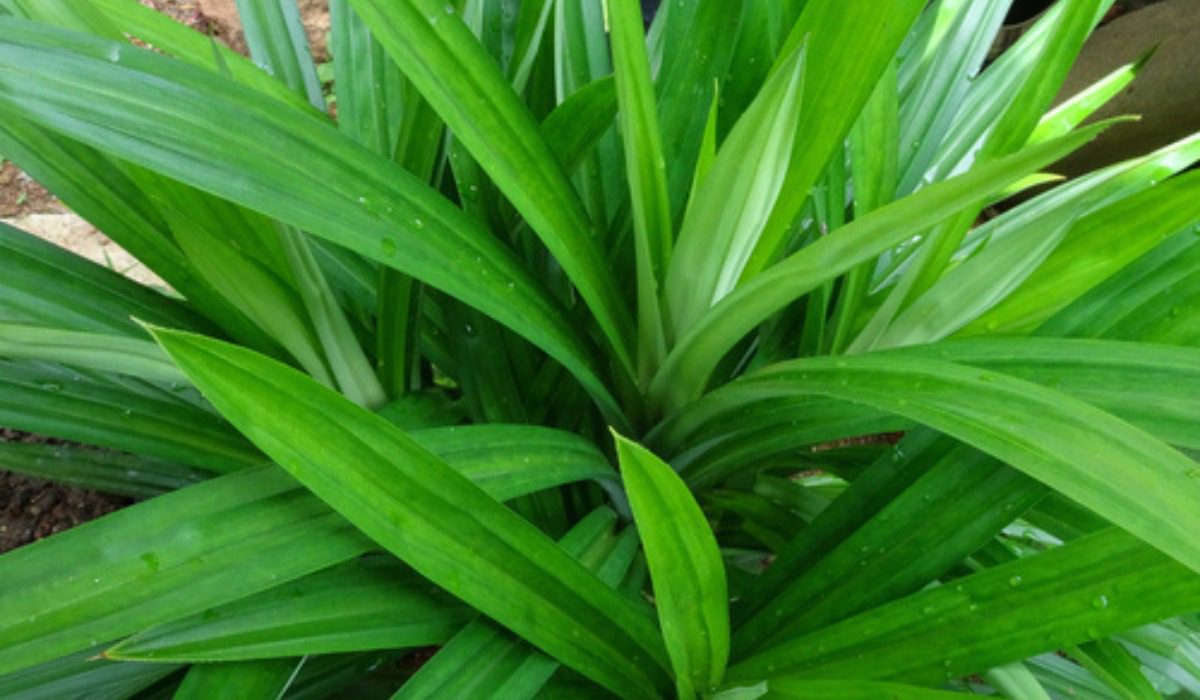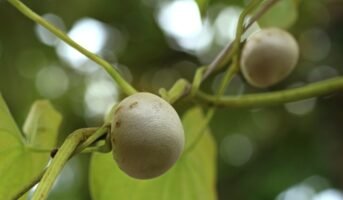There are 600 tropical species of Old World plants and trees in the genus Pandanus, generally known as the screw pine family (Pandanaceae). They flourish in tropical and subtropical locations, particularly in Asia, Africa, and Oceania, alongside coastal areas, marshy areas, and woods.
The broad, elegantly arched leaves of this prickly shrub extend outward from the centre. The screw pine is technically not a pine, and its term originates from the way its branches slightly resemble those of a pineapple.

Source: Pinterest
See also: What are Sabja seeds and how beneficial they are for you?
Screw pine: Key facts
| Botanical name | Pandanus |
| Also known as | Screw pine |
| Leaf type | Long, narrow, parallel-veined, palm-like leaves with spiny margins and midribs |
| Flower | The essence of the blooms on thatch screw pines are known as pandanus or kewra. |
| Height | 20 metres |
| Season | Year-round |
| Sun exposure | Full |
| Ideal temperature | The ideal temperature ranges are 75.2-82.4 °F in the winter and summer. |
| Soil type | Peat, quartz, and coral sand |
| Soil pH | 6-10 |
| Basic requirements | Pandanus grows best in fertile, moisture-retentive soil that drains well. |
| Ideal location for placement | Sea-side |
| Ideal season to grow | Summer |
| Maintenance | Low |
See also: Jasmine and its benefits
Screw pine: Physical description
Aerial prop roots that are frequently enormous are produced from the trunks and stems of Pandanus species, which coupled with their terminal crowns of sword-like leaflets provide the flowers with their distinct look. Pandanus species generally have flexible palm-like stems.
The screwlike helices of leaves that give these plants their popular name, screw pine, are formed by a large number of long, narrow, parallel-veined, palm-like leaves with spiny edges and midribs that are generated in bunches at the branch terminals in three or four tightly coiled ranks around the stem. Simple, without petals, frequently in dense clusters, and can be either male or female, depending on the plant, are the characteristics of the flowers.
Varieties
The screw pine is just one of several species of screw pine that are found all over the world. Its prickly leaves and anchored roots are characteristics of several of its relatives. Nevertheless, domestic cultivation of the majority is uncommon. P. amaryllifolius makes a distinction as it is particularly well-liked in Southeast Asian cuisine as a spice.
Screw pine: How to grow?
Propagation
The screw pine grows from shoots that can be cut off in the spring and planted in a rooting media like perlite or a combination of peat moss and sand. Keep the young shoots warm and wet by covering them with plastic, letting them sit for a few weeks, and misting them frequently.
Repotting
Repot plants every year in early spring, at the start of the growing season, to give them room to flourish. Take care not to harm the roots. As screw pine becomes older, its roots will protrude from the base; whenever you repot it, start covering the stems in soil once more and let them regenerate.
Growers’ Advice
Due to its size, this plant does best as a floor plant and should be kept in an area with lots of light. Make sure to allow plenty of space for the leaves to arch. The screw pine’s leaves, which normally are a pale bluish-green, will become completely green if it doesn’t get enough light; this is a good indicator of whether you are illuminating it well.

Source: Pinterest
Screw pine: How to maintain?
Light: The plant prefers lots of direct light, but it can also live in partial shade.
Water: Water it liberally but infrequently. The top layer of its soil can dry out, but it should never totally dry out. The summer growing season for P. veitchii requires more water, which can then be reduced.
Warm temperatures: Temperatures over sixty degrees are the norm. It’s not tolerant of frost.
Soil: This plant doesn’t have particular soil preferences. The somewhat sandy potting soil works nicely for it.
Fertiliser: Feed a balanced houseplant fertiliser every two weeks during the spring and summer. You merely need to water it once a month during the winter dormant season.
Screw pine: Benefits and uses
Handicrafts are made from pandanus branches. Only mature leaves are cut while collecting leaves from flowers in the wild so that the plant can organically regrow. For further processing, the leaves are sorted after being thinly cut. Basic pandan mats of standard size are made by weavers, or the leaves can be rolled into pandan ropes for different patterns.
Pandan mats are then coloured after this by being deposited in drums with water-based dyes. The coloured mats are formed into finished goods, such as placemats or jewellery boxes after they have dried. Final colour adjustments could be made.
Anti-viral, anti-inflammatory, and antioxidant activities are all present in screw pine. Gout can also be treated with it. It aids in the treatment of damaged nerves.
FAQs
Is screw pine toxic?
No, this plant does not have any known toxic effects.
Why is the plant named screw pine?
Is Pandanus fruit edible?
Yes, the Pandanus fruit is edible.
What does screw pine taste like?
The cones are delicious, and the juice they produce has a flavour similar to thick mango nectar.
Where do screw pines grow?
Although pandanus plants are found on many tropical and subtropical islands and coasts in the Atlantic, Indian, and Pacific Oceans, they are most common on Polynesian and Micronesian low islands and arid atolls.
Housing News Desk is the news desk of leading online real estate portal, Housing.com. Housing News Desk focuses on a variety of topics such as real estate laws, taxes, current news, property trends, home loans, rentals, décor, green homes, home improvement, etc. The main objective of the news desk, is to cover the real estate sector from the perspective of providing information that is useful to the end-user.
Facebook: https://www.facebook.com/housing.com/
Twitter: https://twitter.com/Housing
Email: [email protected]











